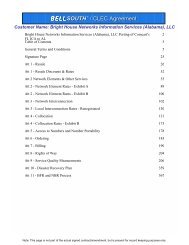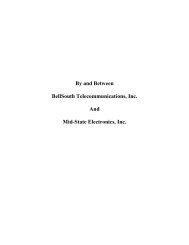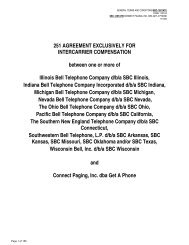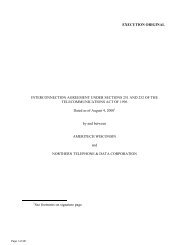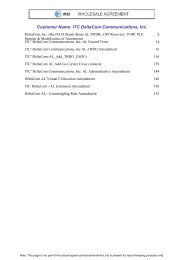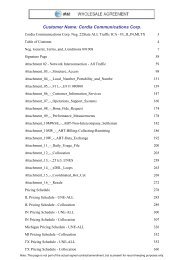Optical Telecommunications, Inc.
Optical Telecommunications, Inc.
Optical Telecommunications, Inc.
You also want an ePaper? Increase the reach of your titles
YUMPU automatically turns print PDFs into web optimized ePapers that Google loves.
Version: 2Q05 Standard ICA<br />
07/06/05<br />
Attachment 3<br />
Page 8<br />
rate shall be as set forth in the appropriate BellSouth intrastate Access Services<br />
Tariff or BellSouth’s FCC No. 1 Tariff.<br />
4.6 For two-way trunk groups that carry only both Parties’ Local Traffic, the Parties<br />
shall be compensated at fifty percent (50%) of the nonrecurring and recurring rates<br />
for dedicated trunks and DS1 facilities. OTI shall be responsible for ordering and<br />
paying for any two-way trunks carrying Transit Traffic.<br />
4.7 All trunk groups will be provisioned as SS7 capable where technically feasible. If<br />
SS7 is not technically feasible, multi-frequency (MF) protocol signaling shall be<br />
used.<br />
4.8 In cases where OTI is also an IXC, the IXC’s Feature Group D (FG D) trunk<br />
group(s) must remain separate from the local interconnection trunk group(s).<br />
4.9 Each Party shall order interconnection trunks and trunk group including trunk and<br />
trunk group augmentations via the Access Service Request (ASR) process. A Firm<br />
Order Confirmation (FOC) shall be returned to the ordering Party, after receipt of<br />
a valid, error free ASR, within the timeframes set forth in each state’s applicable<br />
Performance Measures. Notwithstanding the foregoing, blocking situations and<br />
projects shall be managed through BellSouth’s Carrier Interconnection Switching<br />
Center (CISC) Project Management Group and OTI’s equivalent trunking group,<br />
and FOCs for such orders shall be returned in the timeframes applicable to the<br />
project. A project is defined as (1) a new trunk group or (2) a request for more<br />
than one hundred ninety-two (192) trunks on a single or multiple group(s) in a<br />
given BellSouth local calling area.<br />
4.10 Interconnection Trunk Groups for Exchange of Local Traffic and Transit Traffic<br />
4.10.1 Upon mutual agreement of the Parties in a joint planning meeting, the Parties shall<br />
exchange Local Traffic on two-way interconnection trunk group(s) with the<br />
quantity of trunks being mutually determined and the provisioning being jointly<br />
coordinated. Furthermore, the Parties shall agree upon the IP(s) for two-way<br />
interconnection trunk groups transporting both Parties’ Local Traffic, ISP-Bound<br />
Traffic and IntraLATA Toll Traffic. OTI shall order such two-way trunks via the<br />
ASR process. BellSouth will use the Trunk Group Service Request (TGSR) to<br />
request changes in trunking. Furthermore, the Parties shall jointly review trunk<br />
performance and forecasts in accordance with Section 6 below. The Parties’ use<br />
of two-way interconnection trunk groups for the transport of Local Traffic, ISP-<br />
Bound Traffic and IntraLATA Toll Traffic between the Parties does not preclude<br />
either Party from establishing additional one-way interconnection trunks for the<br />
delivery of its originated Local Traffic, ISP-Bound Traffic and IntraLATA Toll<br />
Traffic to the other Party. Other trunk groups for operator services, directory<br />
assistance and intercept must be established pursuant to BellSouth’s intrastate<br />
Access Services Tariff and/or BellSouth’s FCC No. 1 Tariff.<br />
CCCS 109 of 261




